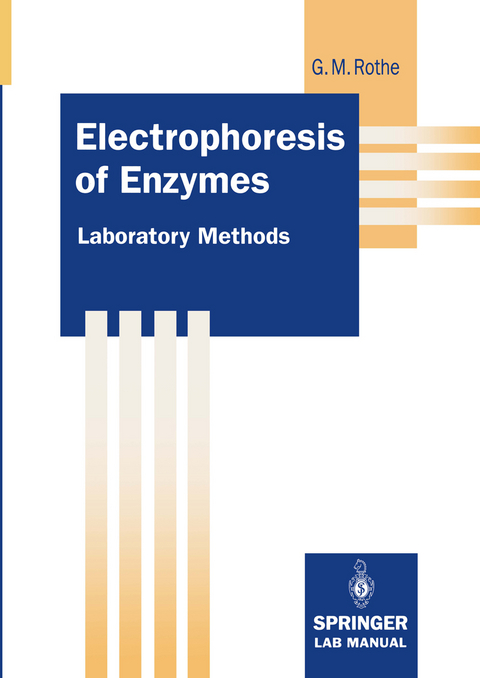
Electrophoresis of Enzymes
Springer Berlin (Verlag)
978-3-642-79071-3 (ISBN)
The electrophoresis of enzymes is a well established technique in biochemical, clinical, environmental, microbiological and forensic laboratories. This book compiles hundreds of proven methods in detail. The exhaustive practical experience of the author and the wealth of material summarized and reviewed makes this book a "must" for every biochemistry laboratory.
1 Introduction.- 1.1 Enzyme Classification.- 1.2 Enzyme Subunit Composition.- 1.3 Isozyme Classification.- 1.4 References.- 2 Extraction of Enzymes from Tissues, Cells and Cell-Organelles.- 2.1 Methods to Extract Enzymes from Microorganisms.- 2.2 Methods to Extract Enzymes from Animal Soft Tissue.- 2.3 Differential Extraction of Cytosolic and Mitochondrial Enzymes from Animal Soft Tissue.- 2.4 Extraction of Insects.- 2.5 Extraction of Plant Tissues.- 2.6 Concentration of Diluted Enzyme Extracts.- 2.7 Mammalian Blood.- 2.8 Pancreatic Islets.- 2.9 Isolation of Subcellular Organelles.- 2.10 Catalytic Activities of Enzymes Forming a Common Metabolic Sequence.- 2.11 References.- 3 Methods for Separating Native Enzymes.- 3.1 General Considerations.- 3.2 Cellulose Acetate Electrophoresis.- 3.3 Starch Gel Electrophoresis.- 3.4 References.- 3.5 Analytical Polyacrylamide Gel Electrophoresis for Separating Native Enzymes.- 3.6 2-D-Electrophoresis under Non-Denaturing Conditions.- 3.7 References.- 4 Sodium Dodecylsulphate Electrophoresis.- 4.1 Homogeneous Buffer Systems.- 4.2 Discontinuous Buffer Systems.- 4.3 Gradient Gel Systems.- 4.4 Enzyme Visualization Following SDS-Electrophoresis.- 4.5 References.- 5 Chemistry of Enzyme Visualization.- 5.1 Methods for Visualizing Oxidative Enzymes.- 5.2 Methods for Visualizing Transferases.- 5.3 Methods for Visualizing Hydrolases.- 5.4 Methods for Visualizing Lyases.- 5.5 Methods for Localizing Isomerases and Ligases.- 5.6 Visualization of Enzymes by Different Methods.- 5.7 References.- 6 A Compilation of Protocols to Visualize Enzymes.- 6.1 Index to Enzyme Recipes and Separation Systems.- 6.2 Protocols to Visualize Enzymes Following Electrophoretic Separation.- 6.3 References.- 7 Data Evaluation in Population Genetics and Evolution.- 7.1 Allozymes as Gene Markers.- 7.2 Population Genetic Measures.- 7.3 Calculation of Dendrograms.- 7.4 References.
"...an invaluable practical guide for a wide application of classical'electrophoretic techniques" - The Analyst
"...an invaluable practical guide for a wide application of classical'electrophoretic techniques" - The Analyst
| Erscheint lt. Verlag | 15.12.2011 |
|---|---|
| Reihe/Serie | Springer Lab Manuals |
| Zusatzinfo | XII, 307 p. |
| Verlagsort | Berlin |
| Sprache | englisch |
| Maße | 170 x 242 mm |
| Gewicht | 562 g |
| Themenwelt | Naturwissenschaften ► Biologie ► Biochemie |
| Naturwissenschaften ► Chemie ► Analytische Chemie | |
| Technik ► Lebensmitteltechnologie | |
| Schlagworte | Biochemie • biochemistry • Chemistry • clinical biochemistry • Electrophoresis • Elektrophorese • Enzyme • enzymes • extraction • Genetics • klinische Biochemie • Microorganism |
| ISBN-10 | 3-642-79071-2 / 3642790712 |
| ISBN-13 | 978-3-642-79071-3 / 9783642790713 |
| Zustand | Neuware |
| Haben Sie eine Frage zum Produkt? |
aus dem Bereich


